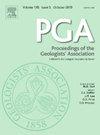Late Cretaceous-Paleocene ostracods and foraminifera assemblages from the Fguira Salah section (Fahs region, northern Tunisia): Biostratigraphy and palaeogeography
IF 1.3
4区 地球科学
Q2 Earth and Planetary Sciences
引用次数: 0
Abstract
The biostratigraphical study of planktic and benthic foraminifera, and ostracod assemblages in the Fguira Salah section (Fahs area, Zaghouan region, NE Tunisia) aims to determine the age of these series for the first time. The vertical distribution of the ostracod species allows to distinguish five successive ostracod assemblages spanning the Santonian, Campanian and Paleocene intervals; with the Maastrichtian interval remaining unrecognised. These assemblages correspond to favourable environments for the ostracods diversity considering their adaptability to various environments. The studied assemblages that support the usefulness of ostracods are precious tools for biostratigraphical correlation and palaeoecological reconstructions. In the Fguira Salah section they contribute to highlighting particular palaeoecological factors, including changes in salinity, water depth, temperature, and hydrodynamism towards the whole palaeoenvironmental evolution in the region and its broader implications.
突尼斯北部Fahs地区Fguira Salah剖面的晚白垩世-古新世介形类和有孔虫组合:生物地层学和古地理
对Fguira Salah剖面(突尼斯东北部Zaghouan地区Fahs地区)浮游、底栖有孔虫和介形虫组合进行生物地层学研究,目的是首次确定这些系列的年龄。介形虫种类的垂直分布可以区分出跨越三东期、坎帕期和古新世的五个连续的介形虫组合;马斯特里赫特间隔仍未被识别。考虑到介形类对各种环境的适应性,这些组合对应着有利于其多样性的环境。所研究的组合支持介形类的有用性,是生物地层对比和古生态重建的宝贵工具。在Fguira Salah剖面,它们有助于突出特定的古生态因素,包括盐度、水深、温度和水动力的变化,从而影响该地区的整个古环境演化及其更广泛的影响。
本文章由计算机程序翻译,如有差异,请以英文原文为准。
求助全文
约1分钟内获得全文
求助全文
来源期刊
CiteScore
2.70
自引率
8.30%
发文量
54
审稿时长
6-12 weeks
期刊介绍:
The Proceedings of the Geologists'' Association is an international geoscience journal that was founded in 1859 and publishes research and review papers on all aspects of Earth Science. In particular, papers will focus on the geology of northwestern Europe and the Mediterranean, including both the onshore and offshore record. Following a long tradition, the PGA will focus on: i) a range of article types (see below) on topics of wide relevance to Earth Sciences ii) papers on aspects of Earth Science that have societal relevance including geoconservation and Earth management, iii) papers on palaeoenvironments and palaeontology of the Mesozoic and Cenozoic, iv) papers on aspects of Quaternary geology and climate change, and v) papers on the history of geology with particular reference to individuals that have shaped the subject. These topics will also steer the content of the themes of the Special Issues that are published in the PGA.

 求助内容:
求助内容: 应助结果提醒方式:
应助结果提醒方式:


